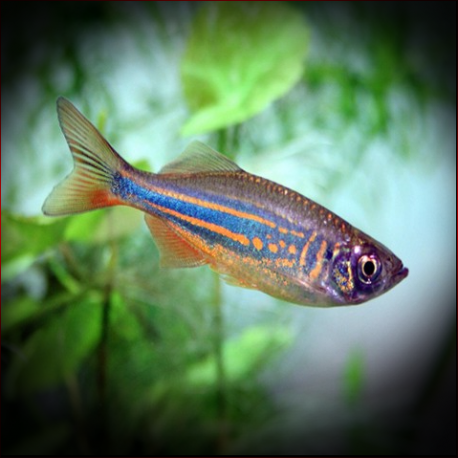More info
Datasheet
| Minimum Tank Size | 240 litres / 63.40 US gallons |
| Maximum Size | 8.0cm / 3.15inches |
| Temperature | 23°C / 73.40°F - 26°C / 78.80°F |
| Hardness | 1.01dgH / 18ppm - 8.01dgH / 143ppm |
| pH | 6.0-7.0 |
General Description
The Devario Acrostomus, belonging to the Cyprinidae family under Cypriniformes classification order, was first introduced to the aquarium trade in the early 2011s. The species is characterized by its sharp, upwardly-pointing mouth, distinctive body patterning with four dark stripes, and a preference for schooling behavior.
Aquarium Setup
Keeping Devario Acrostomus is not challenging in a well-maintained tank resembling a flowing stream or river setup. It thrives in a tank with water-worn rocks, sand, fine gravel, and driftwood. Hardy aquatic plants like Microsorum, Bolbitis, or Anubias spp. can be added as well. Water quality is crucial, with the species being intolerant to organic pollutants and requiring spotless water conditions.
Behaviour
Devario Acrostomus is not aggressive but its constant activity and vigorous feeding behavior may unsettle slower or timid tankmates. It is best suited for larger aquariums housing robust, similarly-sized fish. The species prefers to school, ideally in groups of 8-10 specimens, which reduces stress and creates a natural display. Aggression is minimized within the group as individuals focus on maintaining their hierarchical positions.
Feeding and Diet
In the wild, Devario Acrostomus chiefly preys on insects and their larvae. However, in captivity, it is an unfussy eater and accepts various foods. A staple diet of high-quality dried food supplemented with small live and frozen fare like bloodworms, Daphnia, and Artemia enhances coloration and conditioning.
Reproduction & Dimorphism
Sexual dimorphism is observable in mature Devario Acrostomus. Females are rounder-bellied, less colorful, and slightly larger than males. Males tend to display better colors in the presence of rivals, showcasing territorial behavior during breeding periods. The species engages in typical egg-scattering reproductive behavior.
Habitat and Distribution
Native to the Nam Leuk river drainage in Laos and northeastern Thailand, the species is found both upstream and downstream of the Tad Leuk waterfall. Due to the Nam Leuk Hydroelectric Project, the habitat of D. acrostomus has suffered degradation. Its distribution includes regions with clear to very clear water and various gradients, from steep isolated pools to forested areas and exposed basalt slabs.

